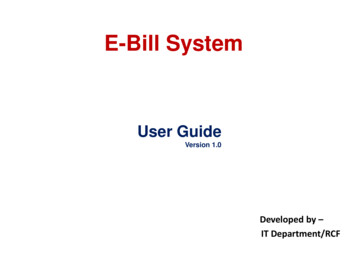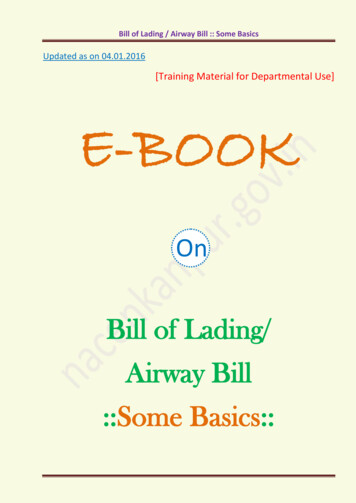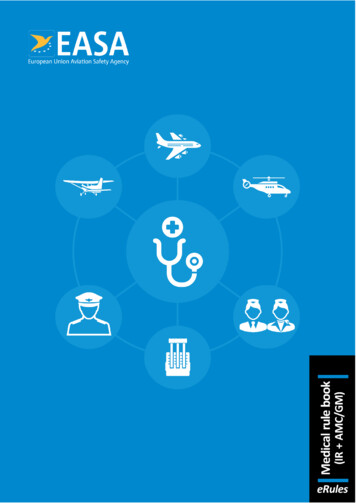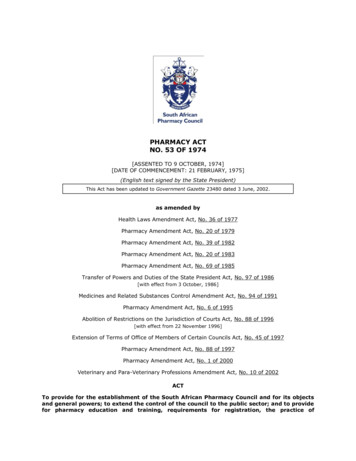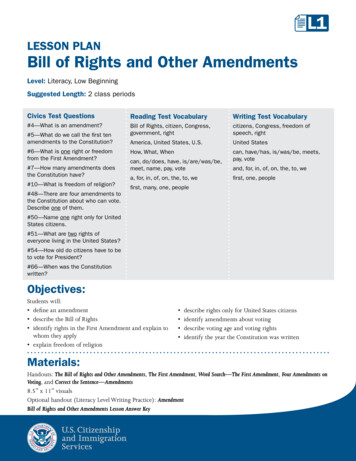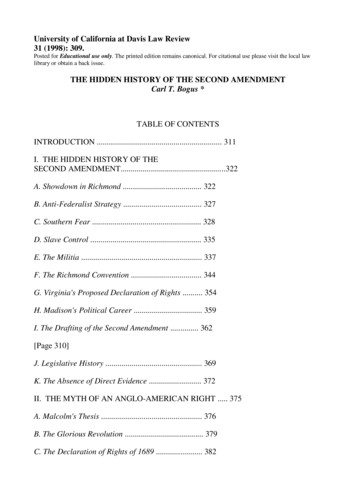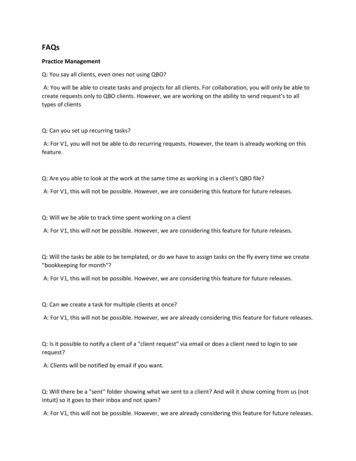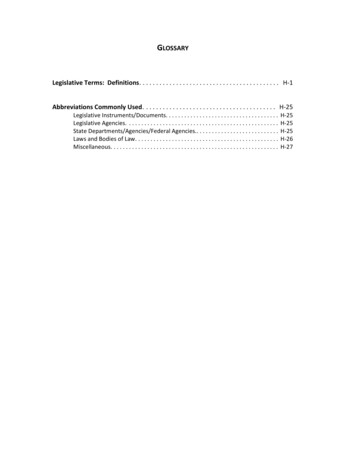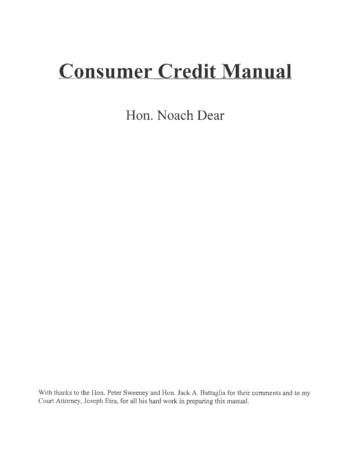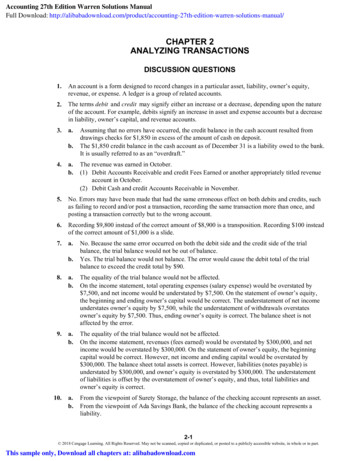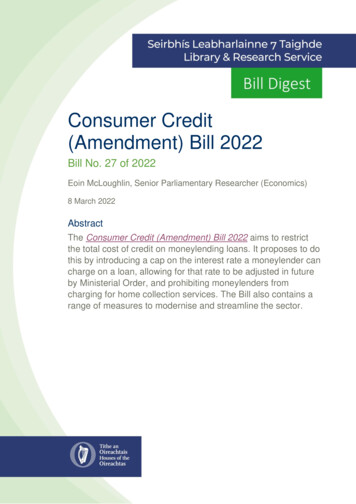
Transcription
Consumer Credit(Amendment) Bill 2022Bill No. 27 of 2022Eoin McLoughlin, Senior Parliamentary Researcher (Economics)8 March 2022AbstractThe Consumer Credit (Amendment) Bill 2022 aims to restrictthe total cost of credit on moneylending loans. It proposes to dothis by introducing a cap on the interest rate a moneylender cancharge on a loan, allowing for that rate to be adjusted in futureby Ministerial Order, and prohibiting moneylenders fromcharging for home collection services. The Bill also contains arange of measures to modernise and streamline the sector.
Library & Research Service Consumer Credit (Amendment) Bill 20221ContentsGlossary and abbreviations . 2Summary . 3Introduction . 5Table of provisions . 7Existing legislative framework . 10Policy background. 12Public consultation . 14UCC report . 14Personal Micro Credit scheme . 15Taskforce on high cost credit. 16Principal provisions of the Bill . 17International approaches. 22This L&RS Bill Digest may be cited as:Oireachtas Library & Research Service, 2022, L&RS Bill Digest: Consumer Credit (Amendment)Bill 2022Legal DisclaimerNo liability is accepted to any person arising out of any reliance on the contents of this paper. Nothing herein constitutesprofessional advice of any kind. This document contains a general summary of developments and is not complete ordefinitive. It has been prepared for distribution to Members to aid them in their parliamentary duties. Some papers, suchas a Bill Digest, are prepared at very short notice. They are produced in the time available between the publication of aBill and its scheduling for second stage debate. Authors are available to discuss the contents of these papers withMembers and their staff but not with members of the general public. Houses of the Oireachtas 2022
Library & Research Service L&RS Bill DigestGlossary and abbreviationsTable 1: Glossary & AbbreviationsGlossary & AbbreviationsAPRAnnual Percentage Rate - calculation of the overall cost of aloan expressed as an annual rate that is used to compare loansof the same amount and term.Cash loan firmsFirms that provide cash loans where repayments can be paidremotely or collected at the consumer’s home.Catalogue firmsGoods are sold on credit, usually on the basis of the consumerhaving a running account.CBICentral Bank of Ireland (‘the Bank’)CUACCredit Union Advisory CommitteeCUDACredit Union Development AssociationCUMACredit Union Managers AssociationILCUIrish League of Credit UnionsMABSMoney Advice and Budgeting ServicePayday loanUsually a short-term, high cost loan, that is typically due onyour next payday.PMC schemePersonal Micro-Credit scheme - Loans under the PMC schemeare provided by participating credit unions and are branded as‘It Makes Sense’ (IMS) loans. Loans range between 100 and 2,000 with a maximum APR of 12.68%.SFFSocial Finance FoundationUCCUniversity College Cork2
Library & Research Service Consumer Credit (Amendment) Bill 20223Summary12 The Consumer Credit (Amendment) Bill 2022 was published on 7 March 2022; The Bill comprises of 15 sections and proposes to amend parts of the Consumer Credit Act1995; The primary purpose of the legislation is to restrict the total cost of credit on moneylendingloans1. It proposes to do this by introducing a cap on the interest rate a moneylender cancharge on a loan, allowing for that rate to be adjusted in future by Ministerial Order, andprohibiting moneylenders from charging for home collection services; The Bill proposes two rate caps, one for cash loans, and one for running accounts.2 Forcash loans, an interest rate of 1% per week to a maximum of 48% per annum on theamount borrowed is proposed and for loans provided on a running account basis, nominalinterest of 2.83% per month on the outstanding balance is to be allowed; Minister for Finance, Paschal Donohoe T.D. wrote to the Joint Committee on Finance,Public Expenditure and Reform, and Taoiseach on 20 July 2021, requesting it to giveconsideration to the General Scheme and to advise whether it requires pre-legislativescrutiny (PLS); The Committee considered the request and decided that it wished to undertake PLS of theGeneral Scheme and sought written submissions from a range of different stakeholders.The L&RS prepared a briefing paper synthesising these stakeholder submissions andhighlighting some key issues. The Committee, having considered the briefing paper,decided that it was satisfied it had undertaken sufficient scrutiny of the Bill and wrote to theMinister on that basis; This Government Bill has similarities to the Private Members’ Bill (PMB) introduced by SinnFéin Deputy Pearse Doherty, the Consumer Credit (Amendment) Bill 2018, which alsoproposes to place a cap on moneylenders’ interest rates. This PMB is currently atCommittee Stage having undergone detailed scrutiny by the Joint Committee on Finance,Public Expenditure and Reform, and Taoiseach. Written submissions from stakeholders onthe Bill were received and three Committee scrutiny hearings were held on 6 May, 12 Mayand 17 June 2021; The Department of Finance undertook a public consultation between May and July 2019seeking views on capping the cost of licensed moneylenders and other regulatory mattersin relation to moneylending. In particular, the consultation sought views on whether theintroduction of a cap would have a negative effect on the supply of credit and might lead toThe Bill deals with licenced moneylenders only rather than illegal lenders or ‘loan sharks’,A ‘running account’ is similar in operation to a credit card account in that borrowers have a credit limit andcan charge goods up to that limit.
Library & Research Service L&RS Bill Digest4an increase in unlicensed moneylending or to financial exclusion for consumers of theseregulated firms; The responses to this consultation helped inform the Moneylending Proposals Report whichwas published by the Department of Finance in July 2021. A number of recommendationsare made in the report, which includes the introduction of an interest rate cap, abolishinghome collection charges, introducing the option to avail of an online repayment book,increasing licensing terms, streamlining the licensing regime and changing the term‘licensed moneylender’ to ‘high cost credit provider’; The Central Bank of Ireland register currently lists 32 licensed moneylenders in Ireland andestimates that there were 313,500 customers with moneylending loan balances outstandingin 2018. According to Central Bank data, the most frequent loan amounts range from 200to 500, with the average loan being 622 and the most frequent loan term being for 9months; The Regulatory Impact Assessment accompanying the Bill stated that it is not expected thatthe proposed legislative amendments will give rise to any significant additional costs, butthere may be some administrative costs for moneylenders who will have to adapt to a newregime; The L&RS has also published a Bill Briefing page on this Bill [internal access only].
Library & Research Service Consumer Credit (Amendment) Bill 20225IntroductionThe Consumer Credit (Amendment) Bill 2022 was published on 7 March 2022. In addition torestricting the total cost of credit on moneylending loans, the Bill also contains a range ofmeasures to modernise and streamline the sector, including: Allowing repayment books to be maintained online; Allowing licenses to be issued for periods of five years at a time rather than one;Removing the requirement for moneylenders to register for a particular District Court area,and register State-wide instead; and Changing the term ‘licensed moneylender’ to ‘high cost credit provider’ to differentiatebetween licensed and unlicensed moneylenders.Announcing the Government publication of the Bill, the Minister for Finance, Paschal Donohoe,T.D., stated that:3“This Bill will reduce the cost of credit for the customers of moneylenders. The legislationalso introduces a range of measures to reform and modernise the moneylending sector.These measures will provide better protection for consumers and will streamline thelicensing process for providers.”The Explanatory Memorandum for the Bill notes that the primary purpose of the Bill is:4“to introduce a cap on the interest rate which a moneylender can charge on amoneylending loan. This is achieved by providing the Minister for Finance with the power tomake regulations setting the maximum interest rate at which a moneylending loan can beprovided. The power is subject to certain principles and policies which are set down in thelegislation, as well as ceilings, in respect of different types of moneylending loans, abovewhich the Minister cannot set the cap. The Minister is also required to consult the CentralBank of Ireland before making such regulations.”Cost implicationsThe Regulatory Impact Assessment states that it is not expected that the proposed legislativeamendments will give rise to any significant additional costs, but there may be some administrativecosts for moneylenders who will have to adapt to a new regime. The RIA further notes that:3See Department of Finance, Press Release, “Consumer Credit (Amendment) Bill 2022 will restrict ratecharged by moneylenders, modernise the sector and better protect those in need of short-term moneylending - Donohoe” (7 March 2022). Available dingdonohoe/4Explanatory Memorandum for the Consumer Credit (Amendment) Bill 2022. Available at: b2722dmemo.pdf (oireachtas.ie).
Library & Research Service L&RS Bill Digest6“if supply were reduced significantly, then customers would have to either do without creditor seek it elsewhere including from family and friends. A small proportion may turn to illegalmoneylenders. This is why any changes in this area must be gradual and not lead tounintended consequences for those customers who depend on a legitimate, functioningmoneylending market in their day-to-day lives.”Pre-legislative scrutiny (PLS)The General Scheme of the Consumer Credit (Amendment) Bill 2021 was published by theDepartment of Finance on 19 July 2021 and the Minister for Finance, Paschal Donohoe T.D. wroteto the Joint Committee on Finance, Public Expenditure and Reform, and Taoiseach on 20 July2021 requesting it to give consideration to the General Scheme and to advise whether it requirespre-legislative scrutiny (PLS).The Committee considered the request and decided that it wished to undertake PLS of the GeneralScheme and sought written submissions from a range of different stakeholders. The L&RSprepared a briefing paper synthesising these stakeholder submissions and highlighting some keyissues. No hearings were held on the General Scheme.The Committee, having considered the briefing paper, decided that it was satisfied it hadundertaken sufficient scrutiny of the Bill and wrote to the Minister on that basis.
Library & Research Service Consumer Credit (Amendment) Bill 20227Table of provisionsA summary of the Bills’ provisions is included in Table 2 below.Table 2: Summary of provisions contained in the BillSectionTitleEffect1.DefinitionIn this Act, “Act of 1995” means the ConsumerCredit Act 1995.2.Amendment of section 2 ofAct of 1995 (Interpretation)Section 2 amends the Interpretation section of theAct of 1995. The terms “moneylender”;“moneylending”; “moneylender’s licence” and“moneylending agreement” have been substitutedby the terms “high cost credit provider”; “high costcredit”; “high cost credit provider’s licence” and “highcost credit agreement” respectively.3.Amendment of section 12of Act of 1995 (Offences)Section 3 adds two new offences. These applywhere a moneylender grants credit which breachesone of the new sections below: Section 94A providing for a loan over 52weeks Section 98A providing a loan with an interestrate over the set caps.4.Amendment of section 92of Act of 1995 (Applicationand interpretation of PartVIII provisions relating tomoneylending)Section 4 of the Bill adds a definition for “nominalrate” as this is the type of interest rate cap beingplaced on running accounts. A running accountoperates similarly to a tied credit card and is aproduct sometimes offered by catalogue companies.“Nominal rate” means the advertised or statedinterest rate, without taking into account any fees,but including any compounding of interestapplicable.5.Amendment of section 93of Act of 1995(Moneylender's licence)Section 5 of the Bill provides for the following:6.Term of loan under highcost credit agreement removes the requirement for providers toregister in each District Court area in whichthey wish to operate extends the licence period from 12 monthsto five years updates the licensing process so that wherea provider’s proposed interest rates areabove the rates set by the Minister at thattime, the Central Bank can refuse to grant alicence.Section 6 of the Bill amends the Act of 1995 by theinsertion of a new section 94A which requires that
Library & Research Service L&RS Bill Digest8cash loans not be granted for a period greater than52 weeks.7.Amendment of section 95of Act of 1995(“Moneylendingagreement” to be stated inagreement)Section 7 of the Bill amends section 95 of the Act of1995 to require providers to include the words "highcost credit agreement" prominently in theagreement.8.Maximum interest ratesSection 8 of the Bill amends the Act of 1995 to inserta new section 98A to provide for the setting of amaximum interest rate that a high cost creditprovider can charge for both cash loans and runningaccounts.Under section 98A, the Minister for Finance may,following consultation with the Central Bank, makeregulations providing for the maximum rate ofinterest at which a moneylender can provide credit.The Minister must have regard to the factorsprovided in subsection (5) when making suchregulations.In making the regulations, the Minister must alsoadhere to the following parameters:9.Amendment of section 100of Act of 1995 (Repaymentbook) In relation to cash loans under a high costcredit agreement:- the maximum rate of simple interestchargeable per week can only beset at a rate less than or equal toone per cent, and- the maximum rate of simple interestchargeable per year can only be setat a rate less than or equal to 48 percent, In respect of a running account under a highcost credit agreement, the maximum rate ofmonthly nominal interest can only be set ata rate less than or equate to 2.83 per cent.Section 9 of the Bill amends the requirement tomaintain a repayment book so as to also include theoption of maintaining an online version of arepayment book if the borrower requests same.The section also inserts a definition of "durablemedium".10.Amendment of section 102of Act of 1995 (Prohibitionon charges for expensesSection 10 of the Bill amends section 102 of the Actof 1995 to include collection charges on the list ofcharges which are not allowed.
Library & Research Service Consumer Credit (Amendment) Bill 2022on loans bymoneylenders).11.Repeal of section 103 ofAct of 1995 (Moneylendingagreements which includea collection charge)Section 11 of the Bill deletes the provisionsregarding collection charges which are no longerallowed.12Provision of information byBank to MinisterSection 12 of the Bill amends the Act of 1995 byinserting a new section 114A which allows theMinister to require the Central Bank to collect andpublish (non-personal) data on the sector. TheCentral Bank shall comply with a request from theMinister under subsection (1).13Transitional provisionsSection 13 of the Bill provides for transitionalarrangements for those who have been issued withmoneylenders licences under section 93 of the Actof 1995 before the passage of the Bill.Due to the changes in terminology, from“moneylender” to “high cost credit provider” in thelegislation, these transitional arrangements ensurethat the appropriate provisions are applied to theholders of existing moneylending licences for theremainder of the term of validity of those licences.14ConsequentialamendmentsSection 14 of the Bill provides for consequentialamendments to the Act of 1995 and otherenactments arising from the renaming ofmoneylenders as high cost credit providers and therenaming of moneylending as high cost credit.15Short title andcommencementSection 15 of the Bill is a standard provision thatprovides for the Minister to commence differentprovisions of the Bill on different dates.Source: Library & Research Service, 20229
Library & Research Service L&RS Bill Digest10Existing legislative frameworkLicensed moneylenders are specifically legislated for under the Consumer Credit Act 1995 (the1995 Act) which sets out a specific regulatory regime for licensed moneylending. An amendment tothe 1995 Act in 2003 transferred responsibility for the licensing and supervision of moneylendersfrom the Office of the Director of Consumer Affairs to the Central Bank.Those wishing to engage in the business of moneylending require a licence from the Central Bankin accordance with the 1995 Act and this licence must be renewed annually. A licensedmoneylender is required to carry on the business of moneylending under the specific terms of thelicence granted by the Central Bank.Section 93(10)(g) of the 1995 Act provides that the Central Bank may refuse to grant (or renew) alicence to a moneylender if it is of the opinion that the cost of credit is excessive. Where suchproposed costs of credit are deemed excessive, the Central Bank can challenge firms to amendtheir business models or to amend the terms and conditions of certain products proposed. As the1995 Act does not define “excessive”, the Central Bank has continued to licence moneylenders atthe maximum rate as per their last licence. In addition, the Central Bank has not licensed anymoneylender to provide a "payday" loan service such as exists in other jurisdictions including theUK.5Moneylenders are required to abide by the Central Bank (Supervision and Enforcement) Act(Section 48) (Licenced Moneylenders) Regulations 2020 (the Moneylending Regulations) whichwas introduced under exercise of the powers conferred on the Central Bank of Ireland by section48 of the Central Bank (Supervision and Enforcement) Act 2013. The Moneylending Regulationswere published in June 2020 and replaces the Consumer Protection Code for LicensedMoneylenders (the Moneylending Code). These regulations seek to strengthen protections forconsumers of licensed moneylending services and enhance professional standards in the sector.The Moneylending Regulations include a requirement on moneylenders to include prominent, highcost warnings in all advertisements for moneylending loans with an Annual Percentage Rate (APR)over 23%. The warning must prompt consumers to consider alternatives. Moneylenders are alsonot permitted to make an unsolicited offer to apply for credit to consumers who have recentlymade, or are nearing, full repayment of a moneylending loan. The Moneylending Regulations aresubject to the Central Bank enforcement proceedings including the administrative sanctionsprocedures.As well as the 1995 Act and the Moneylending Regulations, the other main legislativerequirements that moneylenders must comply with are the European Communities (ConsumerCredit Agreements) Regulations 2010 (S.I. No. 281 of 2010) (the 2010 Regulations) . The 2010Regulations include requirements dealing with disclosure of information to the consumer, the rightof withdrawal from a moneylending agreement, the right to repay a loan early, the right to a5A ‘payday’ loan is usually a short-term, high cost loan, that is typically due on your next payday.
Library & Research Service Consumer Credit (Amendment) Bill 2022reduction in the total cost of credit in the event of early repayment and the moneylender’sobligation to assess creditworthiness.The European Commission is also currently in the process of revising the existing EU rules onconsumer credit and published its proposal on 30 June 2021. This includes introducing anobligation at Member State level to set interest rate or APR caps with national discretion at whatlevel to put such caps.Annual Percentage Rate (APR)APR is a calculation of the overall cost of a loan expressed as an annual rate. It includesall of the known costs involved, such as set-up and any other mandatory charges and theinterest rate expressed as an annual percentage.The APR does not capture the total cost of credit in monetary amounts to the consumer.Rather, it is the total cost of credit expressed as an annual percentage of the amount ofcredit granted, and the APR calculation reflects not just money (amount loaned, repaymentamount and total costs to the borrower), but also time (loan term and frequency ofrepayments).APR is useful when used to compare loans of the same amount and term. With loan termsbelow one year, APRs increase dramatically as the term gets shorter. For example, whenwe look in detail at a loan of 100 with a cost of credit of 25 applied to it, we getexceedingly varied APR rates depending on the term duration. Where the term is set to 4 weeks, the APR for this would be c. 11,455%.Where the terms is set to 13 weeks, the APR would be c. 455%.Where the terms is set to 26 weeks, the APR would be c. 144%.With a term of 52 weeks, the APR would be c. 58%.11
Library & Research Service L&RS Bill Digest12Policy backgroundMoneylending in IrelandUnder the Consumer Credit Act 1995, ‘moneylending’ is defined as the practice of providing creditto consumers on foot of a ‘moneylending agreement’. The business models operated by licensedmoneylenders generally fall within the following categories:Cash loan firms - These firms provide cash loans where repayments can be paid remotely orcollected at the consumer’s home (home collection). The APRs charged in this category are up to287% APR, though a more usual moneylending product, those with terms of 26 weeks, are offeredat rates up to 187% APR.Catalogue firms - Goods are sold on credit, usually on the basis of the consumer having arunning account. A running account is similar in operation to a credit card account in that borrowershave a credit limit and can charge goods up to that limit. The APRs charged by the larger firms rangefrom just under 40% APR to 52% APR.Other - This category comprises of: premium finance firms where credit is provided to consumers to fund insurance premiums,gym membership etc. which are operated on the basis of a consumer having a runningaccount; firms where repayments are made directly to the firm remotely; and retail firms involved in the provision of goods on credit with repayments being made by avariety of methods, (e.g. cash, direct debit).The APRs in this category vary by the products above. A typical APR for premium finance is 60%APR for a 12 month term.In terms of the size of the moneylending sector in Ireland, as of 2 March 2022 there were 32licensed moneylenders listed on the Central Bank of Ireland’s register.6 Figure 1 shows the totalnumber of customers with balances outstanding for each year from 2014 to 2018. The CentralBank estimates that there were 313,500 customers with balances outstanding in 2018, with152,500 (49%) in the Catalogue Firms sector, 123,000 (39%) in the Cash Loan sector, and 38,000(12%) in the “Other” category.76See the Central Bank of Ireland Register of licensed moneylenders spx7Figures have been obtained from the Central Bank directly and the Moneylending: Review of the ConsumerProtection Code for Licensed Moneylenders. Consultation Paper CP118 (2018). Available here.
Library & Research Service Consumer Credit (Amendment) Bill 202213Figure 1: Number of moneylending customers with amounts outstanding 2014 - 2018Source: Central Bank of Ireland (2021)Based on information provided by moneylenders to the Central Bank as part of their annual licenceapplications, the value of loans advanced in 2018 was circa 240 million ( 270 million in 2014).The most frequent loan amounts range from 200 to 500, with the average loan being 622 andthe most frequent loan term being for 9 months.Figure 2: Total amount of loans advanced 2014 - 2018Source: Central Bank of Ireland (2021)
Library & Research Service L&RS Bill Digest14Public consultationThe Department of Finance undertook a public consultation between May and July 2019 seekingviews on capping the cost of licensed moneylenders and other regulatory matters in relation tomoneylending. In particular, the consultation sought views on whether the introduction of a capwould have a negative effect on the supply of credit and might lead to an increase in unlicensedmoneylending or to financial exclusion for consumers of these regulated firms.The Department took the opportunity to seek views on other matters related to the regulation ofmoneylenders including: home collection charges and practices; maximum repayment amounts; the registration and licensing of moneylenders;digitalisation; and advertising by moneylenders and terminology.The consultation received a total of 25 replies, of which two were from individuals, ten were fromlicenced moneylenders including their representative body, seven were from credit unions andrepresentative bodies in that sector and six were from other categories of respondents includingNGOs. According to the Department, the majority of the submissions received were broadly infavour of introducing an interest rate cap. A report setting out these proposals was prepared whichanalysed the various policy options and helped inform the development of the General Scheme.The Moneylending Policy Proposals report was published by the Department of Finance on 19 July2021. A number of recommendations are made in the report, which includes the introduction of aninterest rate cap, abolishing home collection charges, introducing the option to avail of an onlinerepayment book, increasing licensing terms, streamlining the licensing regime and changing theterm ‘licensed moneylender’ to ‘high cost credit provider’. The Consumer Credit Act 1995 wouldneed to be amended to give effect to these proposals. Most of the recommendations from thereport are reflected in the Bill which proposes: Introducing a cap on the interest rate which a moneylender can charge on a moneylendingloan;Abolishing home collection charges;Providing for online repayment books; Streamlining the licensing regime so that licences are in place for five years rather than oneyear and providers not now having to apply in each District Court area in which they wish topractice; and Changing the term ‘licensed moneylender’ to ‘high cost credit provider’ to differentiatebetween licensed and unlicensed moneylenders.UCC reportThe Social Finance Foundation (SFF) requested the Centre for Co-operative Studies, UniversityCollege Cork, to research and produce a report examining the extent and variety of interest raterestrictions on high-cost consumer credit used to achieve the joint policy goals of financial inclusion
Library & Research Service Consumer Credit (Amendment) Bill 202215and consumer protection. The research was jointly funded by the Central Bank and the SFF andwas published in October 2018.8The UCC Report included six key recommendations on interest rate restrictions:1. Government should adopt a policy that prohibits usurious rates of interest in the interests offairness to the most vulnerable in Irish society by the introduction of a restriction on interestrates and charges.2. Such a policy should be conditional on the credit union movement in Ireland committing to andbeing enabled to serve the community currently serviced by the moneylending firms, subjectalways to adherence to prudent credit guidelines.3. In consultation with the credit union sector, the Department of Finance should considerincreasing the 1% monthly cap on interest rates for credit unions as per section 38 (1)(a) of theCredit Union Act 1997, for this type of lending to cater for the significantly greater costsassociated with such small lending.4. The Government should ensure the interest rate restriction is coupled with a limit on other feesand charges and a limit on the total cost of credit, with the rules carefully designed to avoidcircumvention through the introduction of other ‘innovative’ fees and charges.5. The Government should consider reducing the permissible interest, fees and charges onsecond and subsequent loans taken out by c
Payday loan Usually a short-term, high cost loan, that is typically due on your next payday. PMC scheme Personal Micro-Credit scheme - Loans under the PMC scheme are provided by participating credit unions and are branded as 'It Makes Sense' (IMS) loans. Loans range between 100 and SFF Social Finance Foundation UCC University College Cork
